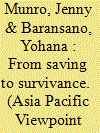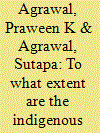| Srl | Item |
| 1 |
ID:
192944


|
|
|
|
|
| Summary/Abstract |
Racism, sexism and gendered violence disadvantage Indigenous Papuan women, yet government responses often focus on individual interventions like ‘raising awareness’ or training. In this article, we build on efforts to challenge these narratives about women's vulnerabilities. We draw on life history interviews with older Papuan women in Jayapura to rethink vulnerabilities and everyday struggles in the context of structural inequalities. We interpret their stories as forms of ‘survivance’ and argue that contrary to dominant perspectives, Papuan women are not economic novices or passive victims. Rather, opportunities have narrowed over time, and women's long history of activity, strategy, persistence and resistance has largely been forgotten. Women's life histories shed light on urban colonialism and Indigenous survivance in Jayapura since the 1940s, when Jayapura was still a Dutch colonial capital and not yet an Indonesian frontier. In a time dominated by concerns about Papuan demise, their experiences are provocative for rethinking vulnerabilities.
|
|
|
|
|
|
|
|
|
|
|
|
|
|
|
|
| 2 |
ID:
095459


|
|
|
|
|
| Publication |
2010.
|
| Summary/Abstract |
Indigenous populations are the most marginalized and vulnerable communities in India, constituting 8.2% of India's total population, four times larger than the total population of Australia. The state of Jharkhand accounts for 27.7% of the total indigenous population of India. This paper compares the health and socio-economic and demographic indicators among indigenous and non-indigenous women in Jharkhand in terms of 'disadvantage ratio', by exploring the data of 1614 ever-married women (women who are currently married or who have been married at some point in their lives) from India's second National Family Health Survey (NFHS-2), conducted during 1998-99. The study revealed that the indigenous women of Jharkhand were highly disadvantaged in terms of socio-demographic, family planning, and important aspects of maternal health and nutrition compared to non-indigenous women. They were not only disadvantaged within the state in different parameters, but also across the indigenous female population of India as a whole. The findings call for urgent implementation of special health care strategies for reducing health and socio-economic/demographic disparities among the indigenous population of Jharkhand.
|
|
|
|
|
|
|
|
|
|
|
|
|
|
|
|